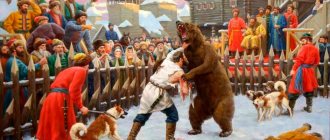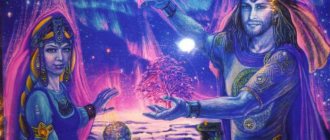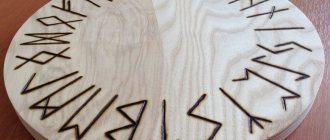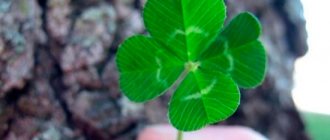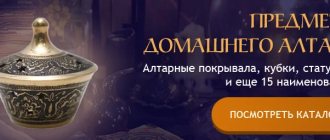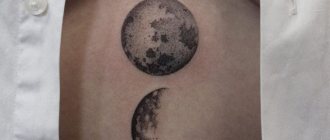Every religion has its own symbols. They are not only drawings that ancient peoples invented out of their own whim or love of art. The images they created are their abstract vision and understanding of God and his essence. This is an allegory that helps people understand the basics of belief, its depth, and its connection with the emotional principle. There are many symbols in our lives, but only religious ones reflect a whole range of moral values, and also have great power and undeniable influence on the common man.
The essence of Islam. Basic symbols of religion
The belief is widespread in Asia. About 23% of people on earth profess Islam, which was founded in the 7th century by the Prophet Muhammad. The concept itself is translated as “obedience to God and peace,” which already reflects the main dogmas of the religion. Muslims preach humanity and harmony in relationships, a correct, honest life for the benefit of society and the Motherland, as well as simplicity, rationality, and the unity of the material and spiritual.
All these rules are described in the holy Koran. According to legend, the book was given to Muhammad by the Archangel Gabriel on behalf of Allah. Since then, all Muslims have respected the canons described on these pages; even the slightest violation of the rules in Asia is severely punished. The symbol of Islam is the crescent moon and its faithful companion, the five-pointed star. They invariably flaunt on all mosques - temples where true believers pray to their Allah. In addition to religious buildings, the symbol of Islam is also often found on the flags of many countries: Turkey, Tunisia, Uzbekistan, Azerbaijan, Turkmenistan, Singapore, Pakistan and others.
The history of the appearance of the crescent
When Islam was born in Muslim communities, symbols of faith had not yet been invented: the idea of the need for their existence did not even occur to people. During Muhammad's lifetime, the army used simple, plain flags: white, green or black. This continued until 1453, when the Turks seized power in the caliphate and occupied Constantinople. They adopted the image of the crescent from the local people: they began to paint it on flags and decorate mosques with it.
According to another legend, the founder of the Ottoman Empire had a dream in which he saw a huge crescent moon that stretched from one end of the earth to the other. The ruler considered this a good sign and decided to make it a symbol of his dynasty. During these times, the crescent and star became the emblem of battle banners and standards. But we should also not forget that the image of the night luminary was actively used long before the emergence of this religion. For example, the current symbol of Islam - the crescent - crowned the head of the ancient Greek goddess Artemis.
DIY Muslim amulet
We have written a lot about the power of Arabic words, but we should mention another type of amulets that are popular among Muslims. The magic of knots is very popular among Arabs. Muslim talismans from threads can be easily made independently if you have certain weaving skills. Since ancient times, it was believed that eastern women, with the help of knot witchcraft, could change fate and attract good luck.
It is interesting that knots were knitted for protection not only in the East. The ancient Slavs also used knot magic - nauz.
A thread amulet helps against damage and evil fate. It is tied on the left ankle. To make such a talisman, take two threads, black and white. Intertwine and tie exactly one hundred and fourteen knots. This is the number of suras in the Koran, it is sacred to Muslims. When you weave, recite Surah “Bakara”.
A Muslim amulet for good luck in personal life is made from green and red threads. They should also be braided and tied into 114 knots and worn only under clothing. A home talisman for good luck is woven from three blue threads and two white ones, and then hides in a remote nook. Three green and one yellow thread will bring good luck in any endeavor.
Crescent and Ottoman Empire
As you know, the Turkish power lasted for hundreds of years. Its inhabitants actively used the symbol of faith in Islam - the crescent, which is why today many people associate it with this particular religion. Although at first it remained simply an emblem of the Ottomans, and not their beliefs. After all, Muslims for many years have vehemently condemned the worship of idols, idols, and any images. They did not have amulets and talismans, icons and religious attributes. Therefore, both during the Ottoman Empire and in the modern world, the crescent moon is rather a symbol of the Turkish people, just as crossed sabers and palm trees are the emblem of Saudi Arabia. In this regard, Muslims can use different images, the main thing is that they do not contradict Sharia.
In the Ottoman Empire, the month was sacred. The Turks said that he plays an important role in people's lives. Firstly, it illuminates the road at night, in pitch darkness. Secondly, thanks to its modifications, a person can navigate in time. The symbol of Islam - a crescent and a star, its constant neighbor, over time transformed into the concept of a “light in the darkness”, which shows the way to all true believers.
Crescent sign in other religions
This sign appeared thousands of years before Islam itself appeared. There are historical references that the star and crescent were symbols of the goddess Diana from Greek mythology and the goddess Tanit, who was revered by the Carthaginians.
This sign can also be found on Orthodox churches: there they are located at the bottom of the cross.
From the results of all these studies, we can conclude that the symbol of the crescent and star is the result of a mixture of the Islamic tradition with those beliefs, traditions and stereotypes that surrounded it throughout its development.
The crescent moon is used in Hinduism, a religion with a thousand-year history, and is an attribute of the god Shiva, one of the top gods, who had a crescent moon adorning his hairstyle. In Hinduism, it is associated with control over your mind and your mental processes.
The ancient Egyptian goddess Ishtar was also associated with the crescent moon sign, which symbolized growth and prosperity in Egyptian mythology.
Many peoples of Asia had a cult of the Moon back in the period of paganism, and in the ancient world this symbol appeared during the Greco-Persian War.
Residents of the Turkic Kaganate used such symbolism very widely: they depicted it on coins that were in circulation.
The Persian Sassanid Empire used the crescent moon as one of its main symbols, even decorating the crowns of its rulers with it.
Opinion of Muslim scholars
They all adamantly claim that the symbol of Islam, the crescent, appeared above Turkish minarets thanks to the ancestors of Alexander the Great. One of them besieged Constantinople, which in those days was called Bayzant. The inhabitants were not afraid, but gave a worthy rebuff and expelled the conquerors. The victory coincided with the appearance of dawn in the sky. It was called a good sign: the crescent began to be depicted on government documents as a memory of those significant events for the city. Further, the image of the night luminary was inherited by the Caesars, who later ruled the city, the center of Byzantium. Well, after them it went to the Ottoman Empire, which managed to conquer these lands.
Today, many Muslims say: some representatives of their religion believe that the crescent is a symbol of Islam, just as the cross is a symbol of Christianity. But this is a big mistake. True believers, they say, worship only Allah, and not pagan images. Therefore, real Muslims who build mosques should not spend money to decorate the building with symbols that have nothing to do with their religion.
Conditions for reciting the Shahada
Calligraphic inscription in Arabic: “La ilaha illa Allah, Muhammadun rasul Allah” - “There is no God but Allah, Muhammad is the messenger of Allah”
Simply saying the Shahada will not be enough. In order for the testimony of Monotheism to benefit the one who utters it before Allah, seven conditions must be met:
- a Muslim should be aware of the meaning of testimony, since the words of the Almighty in Surah “Ornaments” (verse 86) say that one should consciously testify to the truth in order to receive intercession;
- When pronouncing the shahada, a Muslim must be convinced that its meaning is the truth, because only if he has firm convictions will faith benefit him. A Muslim pronouncing the Shahada must be free from guesswork and assumptions. In the Sahih of Muslim, a hadith is narrated that mentions the incident when the Prophet of Allah Muhammad ﷺ, sending Abu Huraira with his sandals, told him that if he meets a person outside the garden who utters a testimony with conviction in his heart, he should make that person happy with the news about heaven. Conviction of the truth of the testimony is the condition for a Muslim to enter heaven;
- a Muslim who reads the testimony must accept what follows from the shahada, not only with his tongue, but also with his heart. The Koran says that Allah punished those nations who refused to accept this testimony and turned away arrogantly from it. According to Allah, the reason for their punishment was “exaltation over the words “there is no god but Allah”, as well as their disbelief in the one who preached to them;
- the Muslim must submit to what follows from the testimony;
- reading the shahadah must be sincere and from the bottom of one’s heart; one should read the shahadah and be truthful when pronouncing it, so as not only to believe in it with one’s lips, but also with all one’s soul. In the hadith of Bukhari, according to the story of Muaz ibn Jabal, the Prophet of Allah Muhammad ﷺ said that anyone who utters a sincere testimony and from the bottom of his heart, Allah will forbid him to touch the fire of hell, implying that truthfulness is salvation from Hell for a Muslim.
- a Muslim reciting the shahada must be sincere and purify good deeds from any admixture of polytheism through his correct intention. The hadith of Bukhari from Abu Hurairah quotes the words of the Prophet Muhammad ﷺ that intercession on the Day of Judgment will be awarded to the happiest of people - those who sincerely and with all their souls pronounced the Shahada.
- a Muslim must have love for this testimony and what follows from it, as well as for what this testimony points to and for those people who are guided by this testimony. And a Muslim should have dislike for what is contrary to the Shahada. According to Allah, there are those among people who associate equals with Allah Almighty and love them as much as Allah. But those who believe love Allah more strongly: “ Among people there are those who associate equals with Allah and love them the same way they love Allah. But those who believe love Allah more …” (Surah Al-Baqarah, verse 165).
What their opponents say
As a counterbalance to the previous judgment, some religious adherents give opposing arguments. They interpret the symbols of Islam and their meaning in their own way. They say that the five-pointed star represents the five pillars of their religion, as well as the five obligatory daily prayers. As for the crescent, it is depicted on mosques and minarets as a symbol of Muslims’ reverence for the lunar calendar.
Discussions between the two opposing sides have been going on for decades, and the first group still uses more convincing arguments. Indeed, if you look deep into history, you can see that at the very beginning the founders of Islam and their disciples did not worship any images or statues. They simply walked around the world and preached their faith. Even religious buildings were then without decorations and symbols. Unlike Christian churches, mosques have a very poor appearance. In the middle there are no icons, altars or gilding - only mosaics on the walls, flowers near the window and carpets for the comfort of believers who bowed in prayer.
Where else is the crescent used?
The answer to this question is very interesting for all history buffs. Why is the crescent moon the symbol of Islam? We have already learned this, as well as the essence of the legends associated with its appearance, the meaning of the emblem and its use. Now let’s plunge into the beliefs of ancient peoples who also revered and worshiped the night star. For example, Buddhism interprets the crescent moon as a symbol of human control over the mind. The Egyptians also believed in his power: turned upside down with his “horns”, he was always depicted next to the goddess Isis.
The Sumerians associated him with the lunar god Sin, the Persians with their Higher powers. But the most interesting thing is that the Christian Celts often depicted him in religious drawings: next to the Virgin Mary. Drawn with its horns facing upward against the background of the saint's belly, it most likely symbolized the feminine principle and the fertile womb. Analyzing all this, we can say: whether to consider the crescent a symbol of Islam or not, everyone decides for himself. The main thing is that it is actively used by many religions, and therefore is rightfully the property of all humanity.
Crescent - from mythical to sacred
Each religion has its own symbolism. Each symbol carries a hidden meaning. Each symbol has its own history of origin, and, perhaps, each of the symbols has one interpretation or another. In our opinion, speaking about the symbol of Islam, the crescent, it is worth, first of all, to touch upon the influence of the moon, as well as the sun, as heavenly bodies on the lives of believers. Here we do not mean their some kind of astrological or esoteric influence on the health, well-being or destiny of a person. Of course not! But we note that such types of worship of a Muslim believer as performing namaz, completing the morning meal and the beginning of the evening meal in the month of Ramadan are determined by the movement of the sun, that is, depending on the location of a given celestial body, during the day, in Islam the beginning of five daily prayers is determined and meal time. The same types of worship as hajj, zakat, al-fitr alms and holidays are tied to certain dates of the lunar calendar. Aspects of the divorce process in Islamic law, such as the waiting period after the death of the spouse, ila (an oath taken by the husband that he will not touch his wife for 4 months) and others, are also determined by the lunar calendar used by all Islamic jurists involved in consideration of a wide range of issues related to the religious practice of Muslims.
The Koran says: “They ask you about the new moons. Say: “They determine the periods of time for the people and the Hajj.” (Baqarah, 189)
.
Prophet Muhammad, peace be upon him, said: “ Start fasting when you see the new month, and end it when you see it. And if the sky was unclear, then determine
"(Bukhari, number 1900 and 1906, from Ibn Umar, Muslim, 2501).
As can be seen from the above canonical texts, the beginning of the month in the lunar calendar is determined by the birth of the new moon. This circumstance made the appearance of the new moon a very important phenomenon in the life of Muslim believers. Since it is the beginning of the month of the Muslim calendar, the Prophet Muhammad, peace be upon him, at the sight of her exalted Allah and made a prayer, asking Allah for good. This prayer goes like this:
«Allah is great! O Allah, raise it (the new month) above us with security, faith, prosperity, Islam and the promotion of what You, our Lord, love and what You please! Our Lord and your Lord is Allah
!” (Tirmidhi, “The Call”, 51).
Many treatises of Islamic scholars, both past and present, are devoted to methods for determining lunar months, which indicates the special significance of the new moon in Islamic law.
Crescent in ancient religious cults
Speaking about the crescent, it is worth remembering that, although there are references to it in the Koran and Hadith, it was not used as a symbol of religion by the first Muslims; on the contrary, the crescent as a religious symbol was used by many ancient cults, including this symbol was widespread among the Turkic-speaking peoples. Let's look at some examples.
Among ancient peoples, the full moon personified beauty and grace; the crescent moon symbolized birth, rebirth, and noble life. Many peoples worshiped the moon, many of them had many myths associated with it. Many myths are associated with the moon among the Turkic peoples, most of whom now profess Islam. One of these myths tells that the Turkic hero Oguz Khan married a girl created from light, from this union the Sun, Moon and Star were born. This myth is very similar to Sumerian mythology (Türker-Küyel, s. 521). Some of these myths are dedicated to the origin of Turkic-speaking and Mongol-speaking tribes. Thus, according to the Egyptian historian of Turkic origin, who lived during the Mamluk period, Aibek ad-Dawadari, the forefather of the Turks is Ay-Atam, that is, the Moon Father (Ögel, I, 485).
At the time when the Uighurs began to move from Tengrism to Manichaeism and Buddhism, their supreme deity “Kok Tengri” - (Heavenly Tengri) began to be called “Ai Tengri” - (Lunar Tengri). This is how the Uyghurs called God during the reign of the Khorezmshah dynasty in central Asia (Ögel, II, 202-203).
In relation to some Turkic khans, a phrase was used in the form of an epithet: “Ay Tanryda kut bulmush”, literally, “The moon found happiness in God” (Kafesoğlu, s. 125-126; Caferoğlu, sy. 1, s. 112-114). According to the Turkish historian Emel Esin, at least a thousand years before the birth of Christ, ancient nomadic peoples perceived the crescent moon with a star as a symbol of power and wealth. Later nomadic societies, especially Turkic-speaking ones, retained a similar tradition of perceiving the image of a crescent with a star. Some clans of the ancient Turks used the crescent moon as their ancestral tamga. This symbol was also depicted on the flags of the Uyghur tribes, including on the standards of the Karakhanid state, which was considered a Muslim empire from the mid-10th century, and motifs resembling a crescent are noticeable on Karakhanid coins (Esin, I, 313 vd.).
The crescent was a symbol of the moon god Nanna in Sumerian-Akkadian mythology. This mark is often found on seals and boundary stones in Mesopotamia. In every culture where there was a god or goddess of the moon, their symbol was the crescent moon (Gray, s. 98-99).
A cylinder seal from the period of the Third Dynasty of Ur depicting the seated king Ur-Nammu, to whom the deity presents one of his nobles. The inscription reads: "Ur-Nammu, mighty hero, king of Ur, Hashkhamer, ensi of the city of Ishkur-Sin, his servant."
On the seal, a crescent moon is clearly visible - the symbol of Nanna.
The crescent moon as a religious symbol was not only used in Mesopotamia, it was widespread in many regions of the Middle East. In Egyptian mythology, there is the moon god Thoth, who is depicted with a crown surrounded by a crescent moon. According to the teachings of Zoroastrianism, one eye of the god Ahuramazda is the moon, the second is the sun.
That
The coins of the Achamenid rulers Darius I and Darius II, which bear their own image, show a crescent moon above their crowns (A Survey of Persian Art, VII, 126, 127). On the coins of the Sassanid Empire, in most cases there is an image of a crescent, sometimes there is an image of a crescent with a star (ibid., VII, 251-252). It is possible that the presence of these symbols on the coins of these states has a sacred meaning.
Note that the inhabitants of Mesopotamia, ancient India, the Aztecs, and the Mayans monitored all phases of the moon and used their observations to compile calendars and determine dates. According to the Old Testament and the Koran, the wisdom of creating the moon is, among other things, so that people could determine calendar dates for themselves. This is also spoken about in the Psalms. Jewish culture has a tradition of celebrating both the new moon and the full moon on the fifteenth day of each month. Observations of the phases of the moon by the mentioned peoples left a certain imprint on their cultures, expressed in the depiction of the crescent symbol on ancient frescoes, paintings, temples and books.
Crescent as a symbol of Islam
The Holy Quran often mentions the new moon, and as we know during the new moon, the moon appears in the shape of a crescent. “They ask you about new moons. Say: “They determine the periods of time for the people and the Hajj” (
Bakara, 189
)
. This verse uses the word “new moon”, in Arabic it sounds like “ahillah” - this is the plural form of the word “hilal”, which translates as “new moon”, “new month”, “crescent”.
In verse 5 of Surah Yunus, Allah mentions the moon, in a general context, using the word “kamar”: “ He is the One Who gave the sun radiance and the moon light. He established phases for it so that you can keep track of years and know the score. Allah created all this only for the sake of truth. He makes clear His signs for a people who know.”
Verses 39 and 40 of Surah Yasin again tell us about the moon - “kamar”: We have predetermined positions for the moon until it again becomes like an old palm branch. The sun does not have to catch up with the moon, and the night does not run ahead of the day. Everyone floats in orbit.
The comparison with an old palm branch indicates the phase of the moon when it becomes “hilal”, that is, at the new moon it takes on the shape of a crescent.
As mentioned above, there are many hadiths and sayings of scientists about the moon and especially about the new moon.
The symbol of the crescent moon has had different meanings for different cultures, but since the new moon in the form of a crescent moon is often mentioned in verses and hadiths, there is perhaps nothing wrong with the fact that some Muslims consider it a symbol of happiness, joy and rebirth. Although we must not forget that this symbol was originally used by various pagan cults, and later passed into Islamic culture. Most historians associate the moment of the transition of the crescent symbol to Islam with the fall of Constantinople under the attacks of the Ottoman Turks in 1453. Even before the birth of Christ, Constantinople, at that time called Byzantium, had a coat of arms that depicted a crescent with a star. Before the arrival of Christianity in the Roman Empire, each city had its own patron or patroness from the pantheon of pagan deities of that time. The deity who patronized Byzantine was the Greek goddess of the moon Diana, who was symbolized by a crescent moon with a star. After the Roman Empire converted to Christianity, many signs, symbols, and rituals that were in service with the pagan priests before successfully transferred to the new religion and acquired a different meaning associated with biblical stories.
Thus, after the division of the Roman Empire into eastern and western, in Byzantium the crescent moon began to personify the mother of the prophet Isa Maryam. This happened in 330 AD, when Emperor Constantine renamed Byzantium to Constantinople, and declared the Virgin Mary to be the patroness of the city. In this case, literally only the name of the patroness changed, but the main meaning of the cult of veneration of the patroness, and the image remained the same. It is also reported that before Byzantium, the crescent served as the coat of arms of the Egyptian city of Alexandria and the city-state, the proud, rebellious Carthage.
Coat of arms of Byzantium (Constantinople) and coin
Virgin Mary with Crescent Moon Carved image of the front of a Carthaginian ship. The coat of arms of Carthage is visible.
The version about the transition of the crescent symbol into the culture of Muslim peoples from the moment of the capture of Constantinople by the Turks is one of the most common, but not the only one. At least we can say with confidence that the crescent as a symbol begins to be widely used by Muslims in coinage starting from the 10th century. During the reign of the Caliph of Umawiya, during the reign of the governor of the province of Tabaristan, Umar bin Al, as well as in southern Iraq during the reign of Hajjaj, coins were used that were minted in Nishapur. These were essentially Sasanian coins with the image of a crescent with a star, only in the center of the coin there were inscriptions with the Shahada, Basmala or some verses of the Koran (Tözen, I, 3, lv. 1-36). During the existence of the Abbasid Caliphate, in some Muslim states independent of the Abbasids, coins with the image of a crescent were minted. So, in the X – XI centuries. Similar coins were minted in the Karakhanid state. Next to the image of the crescent or inside it were placed the inscriptions “lillyah” (for the sake of Allah, belongs to Allah), “adl” (justice), “ilik” (ruler) (Esin, I, 355-356). On one side of the copper dirhams minted in Mosul during the reign of Nasruddin Mahmud Zangi, there is a crescent moon inside which is placed an image of the ruler with a crown (Treasures of Islam, s. 529). The crescent moon was also present on the coins of the Ilkhanid state. According to the Persian historian Mirkhand, the ruler of the Ghaznavid state Sebuk Tegin (circa 942-997) used the crescent as a symbol of his army (Ravżatü'ś-śafâ, IV, 26).
As can be seen from the above, the Muslim rulers of that time did not experience any hostility towards the modern Muslim symbol, although they perfectly understood that they were using the form of coins of Sasanian Iran - a non-Muslim, pagan state, as well as a symbol that did not come to them from the Prophet Muhammad, peace to him.
Sasanian coins
Soldiers with golden crescents
Another argument in favor of the version indicating that Muslims, long before the capture of Constantinople, began to use the crescent symbol is the evidence of Roman chroniclers who described the wars that took place in the European powers, as well as the Crusades.
Thus, according to the Turkish historian Artin Pasha, in 1082 a conflict occurred between the Emperor of Rome Henry IV and Pope VII Gregory. In the same year, the Pope sent his army against Henry, which included Muslim fighters from Sicily, they wore golden crescents on their chests (Yakup Artin Pasha, I/3, p. 39). Note that this incident occurred 17 years before the start of the first crusade. It is also known that the Fatimids, who ruled Egypt in the 10th-12th centuries, wore crescent-shaped necklaces. The use of similar decorations by Muslims of that time is partially confirmed by European medieval miniatures depicting the Crusades. On them we can see crescent motifs, both on the opponents of the crusaders and on their fortresses.
Miniatures dating from 1300 AD. Kept in the museum of the Cathedral of St. Peter's in Rome.
Images of banners of different cities of the Hafsid state on the territory of Tunisia (1229 – 1574)
Temple of “God - Christ” and the house of Allah - from hilal to the cross
By the 10th century, two civilizations, Islamic and Christian, embarked on the path of greatest confrontation. At that time, according to historical reports, both sides already had clear and understandable symbols denoting their cultural and religious tradition. At that time, the cross, being not the only symbol of Christianity, was already widely used and not a single dome of a Christian church of that era could do without it. Historical data gives reason to believe that by that time the crescent had already been used by some Muslim states and dynasties not only as a body adornment, an element of numismatics, or an emblem of the state, by that time Muslims had already erected crescents on the domes of mosques.
So, in 1099, after the fall of Jerusalem under the attacks of the united crusader troops under the command of Godfrey of Bouillon, one of the main mosques of the city, the “Dome of the Rock” was transferred to the order of Augustinian monks, who turned the mosque into a church, and a golden cross was erected on its dome ( Encyclopedia of Islam, VI, 945). When Sultan Salahuddin liberated Jerusalem from the Crusaders in 1187, he ordered the cross to be removed from the dome of the mosque and a sign in the form of a crescent, the ends of which were placed close to each other, to be erected instead (Encyclopedia of Islam, VI, 945). Long before this, in 1064, the Seljuk Sultan Alp Arslan captured the Armenian city of Ani, he ordered the main church of the city to be converted into a mosque. At his command, a large cross was removed from the dome of the temple and a crescent, brought from the city of Ahlat, was erected (Urfalı Mateos Vekayinâmesi, s. 121, Vardabet, I, 195). In 1124, the Georgian army briefly recaptured the city from the Muslims. During this period, the temple was again converted from a mosque into a church, and the dome of the temple began to be crowned with a Christian cross again (Turan, s. 6-7).
Crescent in Turkic-Muslim architecture of Anatolia
The image of the crescent symbol became widespread in the Turkic-Muslim architecture of Anatolia during the Seljuk period. For example, on the outer wall of the Ulu Cami Mosque in the Turkish city of Divrigi there is a double-headed eagle on both sides, as well as three crescents at the base of the bird's tail.
Double-headed eagle of the Ulu Jami mosque in Divrigi
On the walls of the main entrance to the building of the ancient madrasah of the city of Konya, on both sides in a symmetrical form there is a plant depicted, possibly personifying the tree of life. The tree trunk is surrounded by a crescent-shaped ring. A similar image can also be found on the walls of the ancient madrasah in the city of Erzurum.
Main entrance to the madrasah
Crescent as a symbol of the Ottoman Empire
During the reign of the Ottoman dynasty, the use of crescent moon motifs in Turkic-Muslim architecture, architecture, numismatics and heraldry increased. The Ottoman state, from its very beginning, tended to expand its territory. Along with the growth of the borders of the Ottoman Empire, the cultural channels through which the culture of Ottoman Turkey penetrated into the countries of the Muslim East, Africa, Asia and the Balkans also expanded. For this reason, the crescent moon under the Ottomans became a symbol of the entire Muslim world; by that time, the crescent moon began to acquire a religious and political basis.
The proof of this statement is the European map of the world from the 14th century. On this map, northern Africa is indicated by a flag with the image of one crescent, the territory of Central and East Asia is indicated by flags with three crescents. A 15th-century map prepared by Francesco de Genasis based on his travels in the Adriatic shows flags with one crescent and flags with two crescents (XIV-XVIII Yüzyıl Portalan ve Deniz Haritaları, s. 42-43).
On the map of Europe and North Africa made by the European cartographer Giorgio Sideri (1537–1565), the territories that were part of the Ottoman Empire are indicated by flags with a crescent (XIV-XVIII. Yüzyıl Portalan ve Deniz Haritaları, s. 84-85).
World map by Giorgio Sideri
Map of Europe and North Africa. Author: Giorgio Sideri
The crescent moon motif was used by many Muslim states, dynasties, and military formations. Thus, crescent motifs are found on the standards of the Andalusian Sultanate, the Mamluk state and, of course, the Ottomans. We find the first image of a crescent in Ottoman state symbols on the standard of the Ottoman Sultan Selim Yavuz (1470-1520), stored in the Top Kapi Palace Museum. In the middle of the canvas is depicted a zulfiqar - the double sword of the companion of the Prophet Muhammad, peace be upon him, Ali. There are three crescents on both sides of the sword. The first verse of sura 48 of the Koran is inscribed in the two lower crescents, which reads: “ Verily, We have granted you a clear victory.”
The remaining crescents contain the words of monotheism: “There is no god but Allah, Muhammad is the messenger of Allah.”
One crescent on Selim’s banner is also depicted at the base of the sword’s hilt, and in the strip dividing the upper triangular part of the canvas from its main part there are a dozen small crescents depicted. The phrase “O Muhammad!” is inscribed inside two of them, and a large number of stars are depicted inside the others.
Banner of Sultan Selim Yavuz
In the troops of the Ottoman Empire at the Battle of Vienna in 1683, the Turks used a banner in the form of a large crescent on which was written a testimony of faith, the seal of Sultan Suleiman, and an image of small crescents and stars (Çygulski, s. 37-50, rs. 9). The Istanbul Maritime Museum houses the standard of Sultan Mustafa III (1717-1774), which was made for him in Baghdad. The length of the standard is 14 m, width 5 m, weight 56.5 kg. On the standard, along with the image of the Sultan’s tughra and verses from the Koran, there are a large number of images of the crescent moon (Atasoy, p. 42-43). The Topkapi Palace Museum contains items belonging to the sultans of Ottoman Turkey, such as Sultan Suleiman II, Sultan Ibrahim and others. Among the things of the sultans there are ceremonial clothes, silk robes and so on. Crescent moon motifs can be found on almost all types of clothing. Similar motifs are found on the Sultan’s throne of the 16th century, located in the mentioned museum.
Europe began to get acquainted with the Muslim east during the era of the Crusades, and the interpenetration of both cultures continued during the reign of the Ottomans. Typically, when Europeans depicted Muslims and their rulers in their miniatures and engravings, they often used crescent moon motifs.
Thus, in European engravings of the 16th century, which depict Sultan Suleiman and his wife Hurrem Sultan, there is also an image of a crescent. So on one of them, next to the portrait of the Sultan, an emblem with three crescents is depicted. In the engraving depicting Hurrem Sultan, the clothes of Suleiman’s wife are decorated with motifs of this symbol (Ward, s. 17, 51).
Suleiman the Magnificent in a Venetian engraving
Venetian engraving depicting Roksolana (Hurrem Sultan)
Another engraving depicts Sultan Suleiman going to Friday prayers, in his hands a staff on the handle of which a crescent moon is visible (Ward, p. 50). Another miniature shows Suleiman standing at the gate of the mosque, with an image of an elephant, whose head is decorated with crescents, visible above his head. The crescent moon in this miniature is present both on the flag and above the gate of the mosque (Ward, p. 48).
Suleiman II (1642-1691) used the crescent and star symbol as the emblem of his army and navy. At the top of his seal is a crescent moon with a six-pointed star (Kütükoğlu, s. 86; Özdemir, s. 77, 79). During the reign of Sultan Mahmud II (1784 – 1839), the image of a crescent with a star began to be used in official documents. On one of these documents of that time you can see the Sultan’s tughra, above it the emblem of the state, and above it two crescents facing each other, with a fourteen-pointed star placed between them. In addition, the state emblem depicts three crescents with stars (Özdemir, p. 82). On the seal of the Ottoman ambassador to Paris, sent there by the Sultan in 1835, there is an image of a crescent with a five-pointed star (Kütükoğlu, p. 90).
It is worth noting that the image of a crescent moon is present, including in European culture, perhaps this is a consequence of cultural exchange with the Muslim east. As an example, we can cite French tapestries of the 16th century, where a crescent moon is widely represented in the form of a family coat of arms.
One of the six tapestries "The Maiden and the Unicorn". Three banners each feature three crescents, and the flagpoles are also decorated with this symbol.
Hilal - the hidden name of God
In this article, we examined the history of the emergence of the crescent symbol, its meaning in certain cults, as well as various practices of use. But besides all this, the sacred meaning of this symbol cannot be ignored. It had a sacredness, in almost all cults that used it, Islam is no exception, in some forms of which many elements of ancient cultures and religious traditions are intertwined, especially those related to religious symbols. We said that in ancient cults the crescent moon was a designation for one or another character in various pagan mythologies, but in Islam it also has a similar hidden meaning.
The fact is that the Arabic language has a system for notating numbers using Arabic letters. The system itself is called Abjad. This system was inherited by the Arabs from other Semitic tribes. In addition, in Islamic philosophy, some letters denote some abstract phenomena or something global. For example, the letter “alif” denotes the unity of Allah, and the letter “ba” denotes the universe. The use of abjad is found in Islamic architecture. If we look at the ancient fountains of Istanbul, we will see on the tablets of these fountains texts that contain information about the architect, builder, philanthropist who made an effort in creating this object. Often they have texts with good wishes for them. But you can often notice that the date of construction of a fountain or other ancient object is not indicated, but only at first glance it seems that it does not exist, in fact it exists and it is hidden in the letters of the Arabic alphabet, built according to the abjad system. To understand the connection of what has been said with the topic we are discussing, we need to derive numbers from the Arabic letters that denote the word “Allah.” So, let's try:
alif + lam + lam + kha = 1 + 30 + 30 + 5 = 66
We took the numerical value of each letter of the word “Allah”, added them up and got the number - 66.
What does this have to do with our topic, the crescent moon?
Let's remember how the word crescent sounds in Arabic.
هلال
hilal
Yes, hilal. Let's display the numerical value of the Arabic letters of this word:
ha + lam + alif + lam = 5 + 30 + 1 + 30 = 66
It turned out to be 66, as in the word “Allah”.
There is another symbol that was often used in the architecture of Ottoman Turkey. This is a tulip.
Lale
This is a Persian word, denoted in Arabic letters during the Ottoman period. Why are there many images of tulip motifs in the architecture of Turkish mosques? To answer this question you need to use an abjad:
lam + alif + lam + ha = 30 + 1 + 30 + 5 = 66
All three words have the same total letter value - 66. The last two words point to the first, that is, to the word “Allah”. Accordingly, the symbol of the crescent, used by Muslims since ancient times, although it was borrowed from other cultures, still has a hidden, sacred meaning, pointing to the name of the single Creator - Allah Almighty.
Conclusion
Today, the crescent as an official symbol is used by the Red Crescent organization, created in the Ottoman Empire as an analogue of the Red Cross. The crescent is the official emblem of the Green Crescent organization, which fights the spread of drugs and alcohol. The crescent is depicted on the national flags of such countries as Azerbaijan, Algeria, Cameroon, the Turkish Republic of Northern Cyprus, Malaysia, Mauritania, Pakistan, Singapore, Tunisia, Turkmenistan, Turkey and others.
The crescent began to be widely used by Muslims from the 10th-11th centuries, as opposed to the religious symbolism of Christians, who at that time used the cross as a religious symbol.
With the capture of Constantinople by the Turks, the use of the crescent symbol expanded many times (Yakup Artin Paşa, I/3, pp. 39, 49). The crescent moon can rightfully be considered a symbol of Islam, since the Quran and Hadith repeatedly mention the new moon, which has the shape of a crescent. Moreover, Allah in the Koran often swears by this heavenly body, and the numerical value of the letters of the word “hilal” - (crescent) has the same total value with the letters of the word “Allah”. In addition, in the history of Islam, it is unknown that any of the theologians of the past and modern times spoke about the prohibition of using the crescent as a religious symbol. Considering that in the Islamic world, throughout the existence of the teachings of the Prophet Muhammad, peace be upon him, many disputes and unrest arose regarding various issues relating to religious and political beliefs, then the emergence of disputes regarding the use of the crescent by Muslims has not been documented. Source:
alhakk.ru
Share this post
